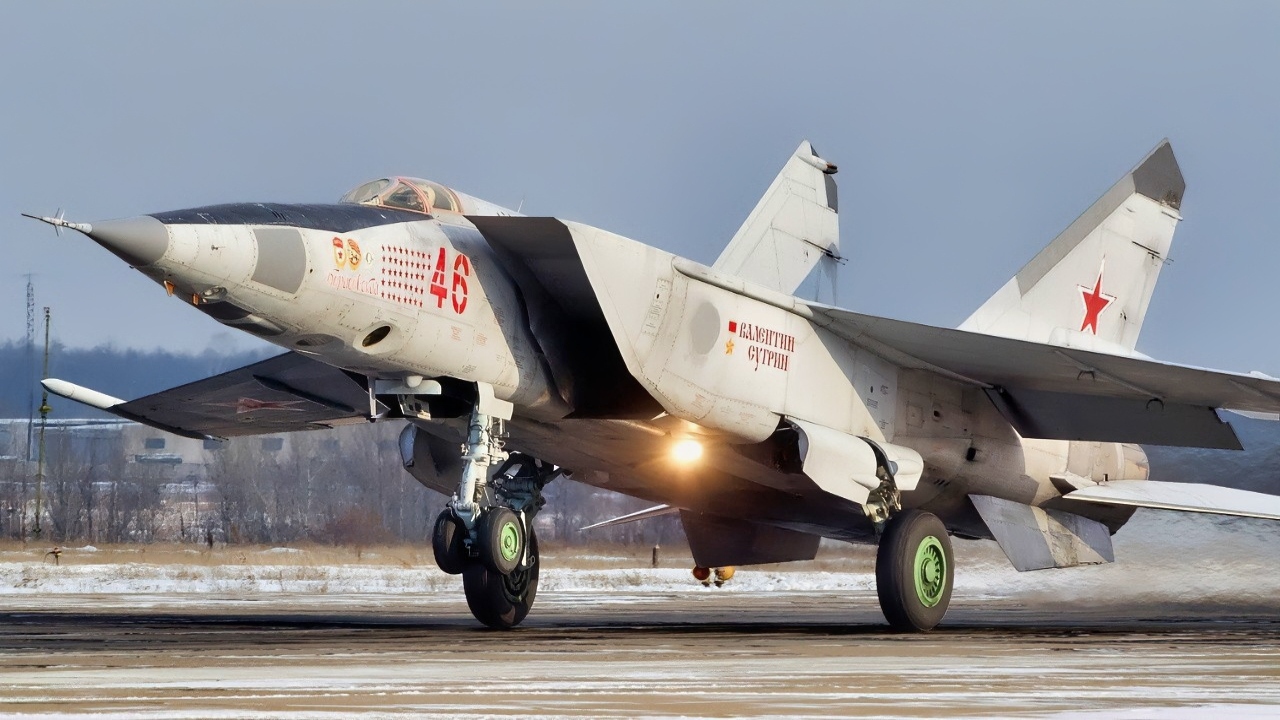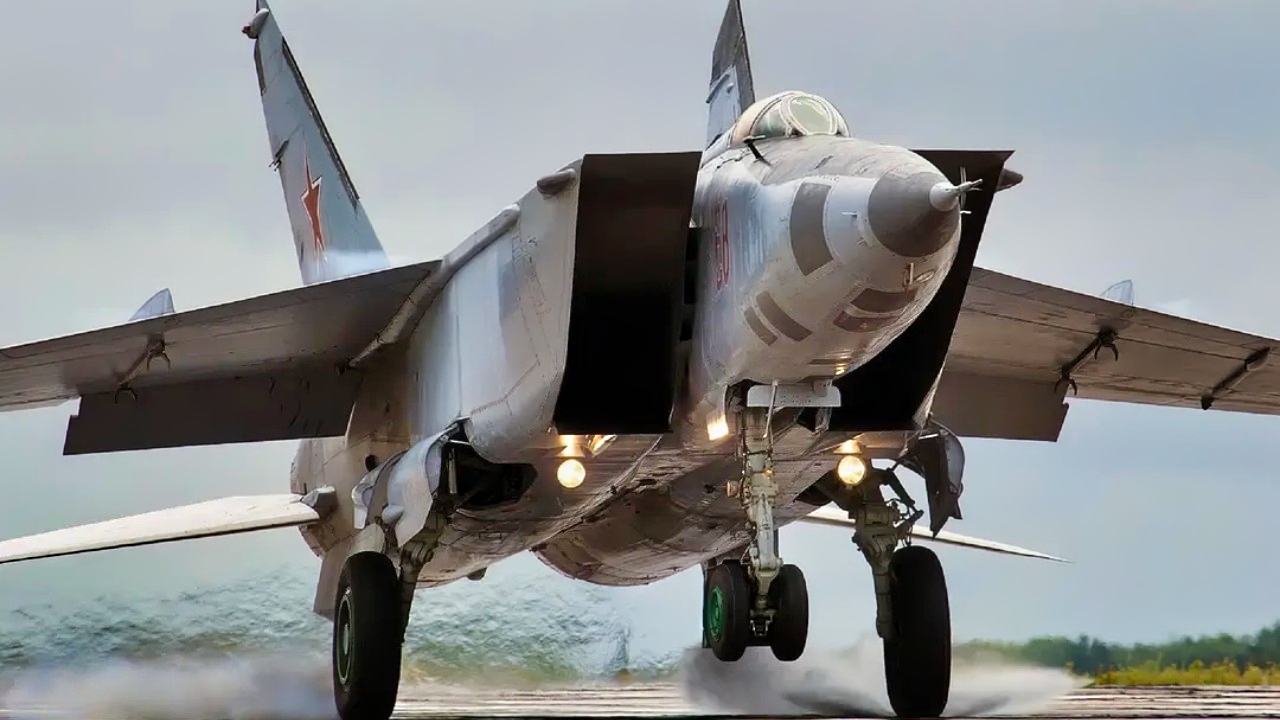Key Points and Summary – During the Cold War, two Soviet pilots handed the West priceless insights by flying their jets to freedom. In 1976, Viktor Belenko landed his MiG-25 Foxbat in Japan, letting U.S. engineers discover its nickel-steel construction, fuel-hungry engines, crude vacuum-tube radar and limited agility—revealing it was built to chase bombers, not dogfight.

MiG-25 Taking Off. Image Credit: Creative Commons.
-In 1989, Aleksandr Zuyev sedated his squadron with a spiked cake, shot his way to a MiG-29 Fulcrum and defected to Turkey, giving NATO an inside look at the jet’s performance, maintenance burdens and tactics.
-Together, their gambles rewrote Western assumptions about Soviet airpower.
How Stolen MiG-25 and MiG-29 Fighters Gave America a Soviet Airpower Roadmap
During the Cold War, not all Soviet Union air force pilots were created the same. Some would have never even thought of betraying the Motherland, but for two disloyal aviators, stealing a fighter jet seemed like the most straightforward thing to do. In 1976, a Russian pilot named Viktor Belenko swiped his MiG-25 Foxbat and landed in Japan.
In 1989, Aleksandr Zuyev defected to the West along with his MiG-29 Fulcrum.

MiG-29 Fighter. Image Credit: Creative Commons.
Both actions shocked the world. Belenko was flying a training mission out of Vladivostok. He flew over the Sea of Japan, and then Japanese radars spotted him over Hokkaido.
They sent F-4EJs to investigate. Belenko’s MiG-25 was running short of fuel, and he needed to land anywhere possible. He spotted a civilian airport at Hakodate.
This was going to be a gamble because of the short runway. Somehow, Belenko skidded to a stop before he ran out of space.
Viktor Belenko’s Story With the MiG-25
The Japanese were unsure of what to do with Belenko after they recovered from the shock of the incident. They finally contacted the American embassy for directions. Belenko wanted to switch sides.
The Japanese air force loaded the MiG-25 into a C-5A cargo plane at Hyakuri Air Base. There, the MiG-25 was in pieces, and technicians, engineers, and pilots were astounded by how lucky they were to capture the fighter jet.
What Did the Group Find?
The group inspecting the components quickly discovered that the MiG-25 was made of nickel steel, not titanium. This was unexpected. The Soviets had chosen a metal that made the MiG-25 heavy but still allowed for a speed of MACH 2.83. The engines were twin Tumansky R-15 series turbojets, which enabled that high speed.
The MiG-25 was a gas hog, though, and the Soviets had chosen speed over fuel efficiency and range.

MiG-25 Foxbat. Image Credit: Creative Commons.
The technicians found that the radar was an older model that used vacuum tubes. This was not a look-down shoot-down radar, and that was a significant finding. The Soviets were behind in radar technology. At high altitude, the sensor could perform its job, but the radar struggled to loiter low over a target.
The airplane also sacrificed agility due to its heavy weapons load-out. The MiG-25 carried bulky R-40 Acrid missiles. This sacrificed agility.
The airplane was also limited in the amount of G-force it could take on. Hard turns were made difficult, and the flight controls were assuredly not as good as those of Western counterparts. The engineers surmised that the MiG-25 was more suited to intercept American nuclear-armed bombers than to be a hugely successful dogfighter.
However, that high speed was an advantage that allowed it to escape trouble after destroying a bomber, enabling it to outrun enemy fighters when necessary.
The Legend Behind the Exploits of Aleksandr Zuyev
The 1989 Soviet airplane defection was equally astounding. Soviet Air Force Captain Aleksandr Zuyev had seen enough of Russian decadence, and he despised communism. He figured the USSR was melting away after the Berlin Wall came down. This was a good time to make a run for it.
Zuyev took his MiG-29 Fulcrum from the Black Sea to Trabzon, Turkey. He believed the Turks, as NATO members, would protect him and eventually deliver him to the United States for safekeeping.
Zuyev had been stationed at Mikhe Tskhakaya airbase in the Soviet Republic of Georgia. He flew the vaunted Fulcrum, which was the Russian answer to the F-15 and F-16. His MiG-29 had the kind of performance that was adored, thanks to its advanced avionics and agility. The powerful engines propelled the vehicle at a speed of MACH 2.3.
Zuyev’s Defection was ‘Baked In’
Zuyev had an unorthodox plan for defection. This whole escapade was out of a Hollywood spy movie. He held a party for his wife, who feigned pregnancy. The Soviet pilot baked a cake and inserted sedatives inside. Everyone at the gathering ate the confection and soon passed out from the drugs. Zuyev laid waste to the telephone lines and, due to the confusion around him, tried to board his Fulcrum. There was a problem – armed guards.
This did not deter Zuyev. There was an exchange of gunfire, and the defector sustained an injury to his right arm. Could he still fly the airplane?
Zuyev drove on with his plan despite the pain. He wanted to take out a few fighters with the Fulcrum’s guns, but they were locked down. He took off anyway and made it to Turkey. The Turks returned the airplane to the Russians.
Anecdotal Evidence Was Still Valuable
Zuyev was debriefed for an extended period. He revealed that the MiG-29 had ample performance traits. As an experienced pilot, he explained the intricacies of the airplane’s speed and how it glided through the air. What he knew about the weapons systems was valuable.
Zuyev gave clues about the sensors on board. The defector also knew how difficult it was to keep the MiG-29 airborne and how many hours it could fly before maintenance was required.
The traitor to the Soviet Union also related tactics and techniques of the MiG-29 when flying in combat. This was valuable information about how the Soviets would try to attack American fighter jets if the airplanes entered a dogfight.
These two stories were dramatic and the stuff of legends. The Americans learned more about the MiG-25 because they had the actual components of the airplane. For the MiG-29, they had to take Zuyev at his word. But his exploits could have been the makings of a movie and probably inspired the film “Firefox” with Clint Eastwood in 1982, in which the hero attempts to steal an ingenious Soviet fighter.
Too bad there are no Russian pilot defectors today. It would be nice to see a Su-57 Felon diced up in parts. The Russians learned from their Cold War experiences and are likely to ensure their fighter pilots remain loyal to their country.

Su-57 Felon Artist Image> Image Credit: Screenshot.
However, it wouldn’t surprise me if some Russian aviators have considered leaving their country with a fighter. Vladimir Putin should watch out before he scares some disloyal pilot into leaving.
About the Author: Brent M. Eastwood
Author of now over 3,000 articles on defense issues, Brent M. Eastwood, PhD is the author of Don’t Turn Your Back On the World: a Conservative Foreign Policy and Humans, Machines, and Data: Future Trends in Warfare plus two other books. Brent was the founder and CEO of a tech firm that predicted world events using artificial intelligence. He served as a legislative fellow for US Senator Tim Scott and advised the senator on defense and foreign policy issues. He has taught at American University, George Washington University, and George Mason University. Brent is a former US Army Infantry officer. He can be followed on X @BMEastwood.
More Military
Could America Have Lost the Revolutionary War?
The Marines Don’t Have Tanks Anymore
The Essex-Class Aircraft Carriers Have An Embarrassing Message for the U.S. Navy
‘New’ Mach 4 MiG-41 6th Generation Stealth Fighter Has Warning for U.S. Air Force
Boeing’s F-47 NGAD 6th Generation Stealth Fighter Is No ‘Mission Impossible’










